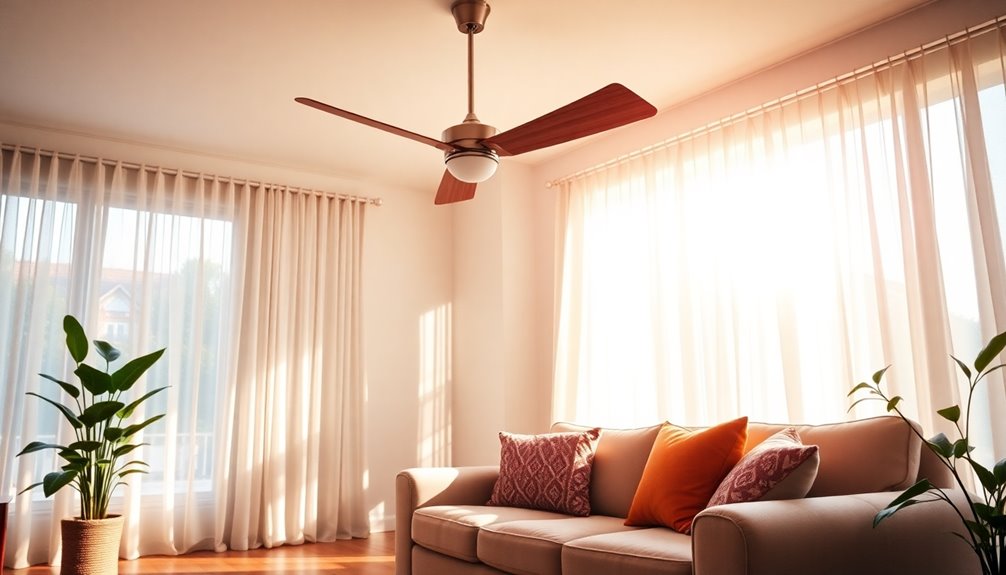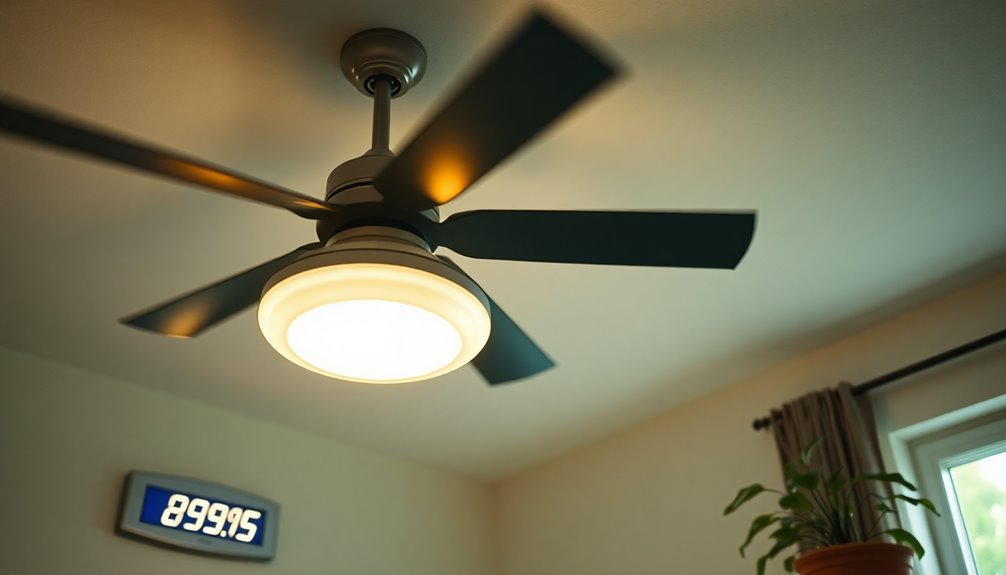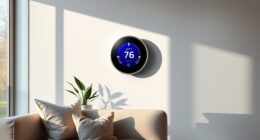The color temperature of fan lights impacts your room’s mood by influencing how warm or cool the space feels. Cooler tones around 5000K create a bright, energizing environment, ideal for work areas or modern spaces. Warmer hues near 2700K produce a cozy, inviting atmosphere perfect for relaxing or intimate settings. Adjusting the temperature allows you to personalize your space, shaping the vibe you want—if you keep exploring, you’ll discover how to choose the perfect setting for each room.
Key Takeaways
- Cool white (around 5000K) creates a bright, energetic atmosphere ideal for workspaces and modern decor.
- Warm white (around 2700K) produces a cozy, relaxing environment suitable for bedrooms and living rooms.
- Adjusting color temperature influences room mood, from stimulating to calming, enhancing overall ambiance.
- Cooler tones promote alertness and focus, while warmer tones foster relaxation and intimacy.
- Proper lighting choices support activity-specific needs and improve visual comfort within the space.
Understanding Color Temperature and Its Measurement

Understanding color temperature is essential because it describes the quality of light emitted by your fan lights, affecting the room’s atmosphere. When selecting bulbs, pay attention to color temperature ratings, measured in Kelvin (K). Cool white lights (around 5000K) produce bright, bluish light, while warm white bulbs (around 2700K) create a cozy, yellow glow. These choices influence not only the room’s mood but also bulb lifespan and energy efficiency. Cooler bulbs tend to last longer and often consume less energy, making them cost-effective options. Warm bulbs may offer a softer ambiance but might have shorter lifespans. Choosing the right temperature helps you set the desired mood while maximizing your bulbs’ efficiency and longevity. Additionally, understanding color temperature effects can help you create a balanced and comfortable environment in your space. Recognizing the impact on ambiance can guide your lighting choices to better suit your lifestyle and preferences, especially since lighting quality plays a crucial role in setting the overall room tone.
The Warm Side: Creating Cozy and Inviting Spaces

Creating a cozy and inviting space starts with choosing the right lighting, and warm white fan lights are perfect for this purpose. Their soft, amber glow enhances the room’s ambiance, making it feel welcoming and comfortable. You can highlight decorative accents like textured walls, plush furniture, or artwork with warm lighting, adding depth and charm. Additionally, warm fan lights are energy-efficient, so you enjoy a cozy environment without high electricity costs. This type of lighting encourages relaxation and intimacy, perfect for living rooms, bedrooms, or reading nooks. By selecting the right warmth level, you create an atmosphere that feels both inviting and functional. Incorporating energy efficiency and natural materials like wood and linen can further enhance the cozy farmhouse vibe. Using warm lighting can also help reduce light pollution, creating a more tranquil and serene space. With warm fan lights, you set a mood that encourages gatherings, quiet evenings, and restful nights.
The Cool Spectrum: Energizing and Modern Atmospheres
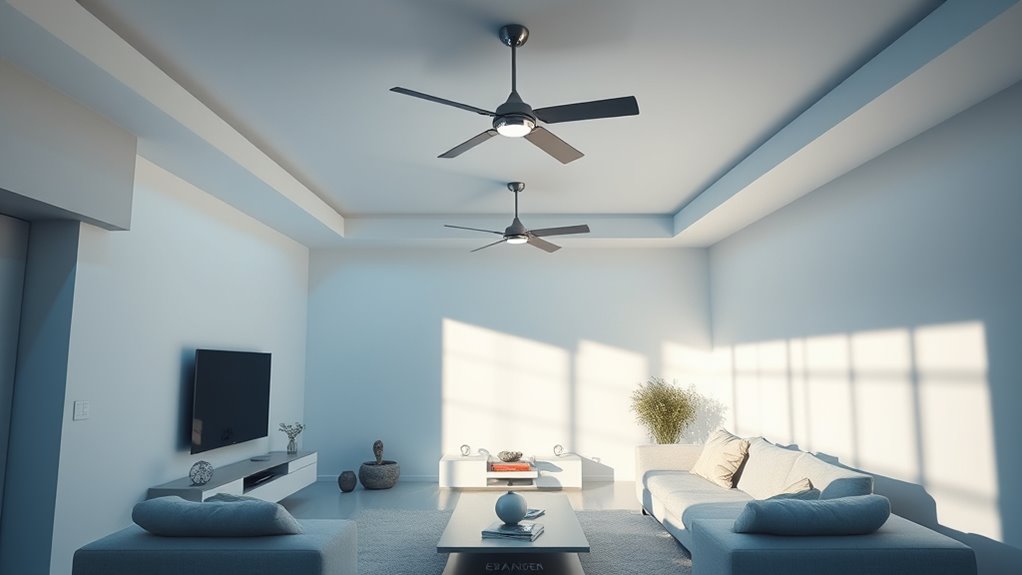
Switching from warm, cozy lighting to cooler tones instantly transforms your space into a sleek, energetic environment. The cool spectrum, with its bluish hues, is known in color psychology for promoting alertness and focus, making it ideal for workspaces or modern living areas. These tones can enhance your room’s sense of freshness and sophistication, giving it a contemporary vibe. Additionally, cooler lighting often reduces eye strain, providing better eye comfort during tasks or extended periods of activity. When you choose fan lights with a cool color temperature, you create an atmosphere that feels vibrant and invigorating. Just keep in mind that while it energizes your space, balancing these tones with other elements guarantees your room remains comfortable. Implementing vertical storage solutions can further optimize space and support the modern, organized ambiance created by cool lighting. Also, incorporating lighting control systems allows you to adjust color temperatures easily, tailoring the mood to your needs at any given time. To maximize the benefits, understanding the power and performance of your lighting options can help you select the most suitable fixtures for your space.
Balancing Brightness and Color Temperature for Comfort
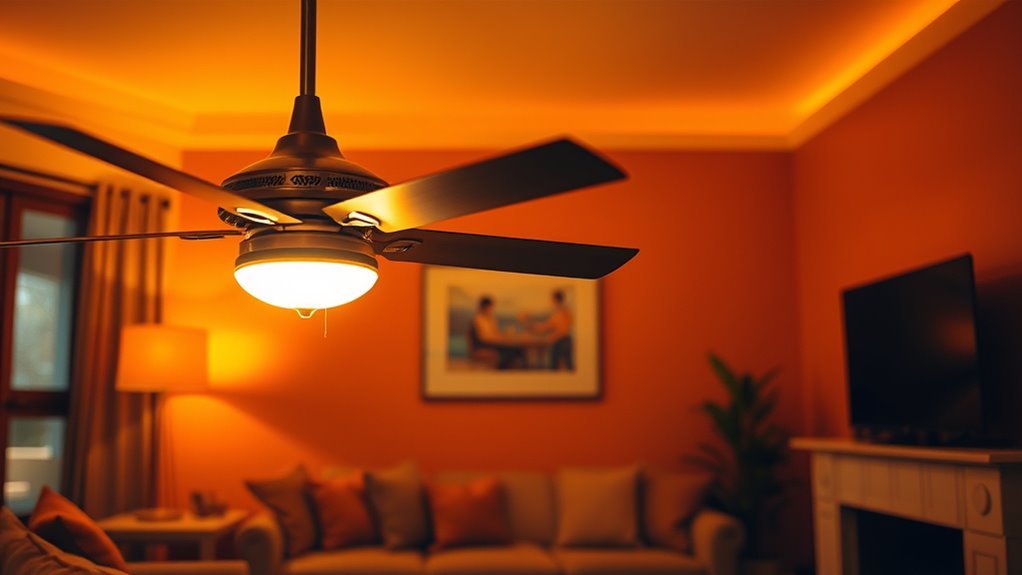
Balancing brightness and color temperature is essential for guaranteeing your space feels comfortable rather than glaring or dull. Proper lighting design considers how light intensity and hue influence mood and functionality. Using the right brightness prevents eye strain and creates a welcoming environment, while adjusting color temperature taps into color psychology to evoke specific feelings—warm tones foster coziness, cool tones promote alertness. When these elements work harmoniously, your room feels inviting without being overwhelming. You can achieve this balance by selecting dimmable fixtures or fan lights with adjustable settings. Keep in mind that different activities may require varying lighting levels and temperatures, so customizing your setup ensures ideal comfort and mood. Additionally, understanding appliance lighting options can help you incorporate energy-efficient and smart solutions to optimize your room’s ambiance. Being aware of how dream symbolism influences perception can also help you create a space that aligns with your subconscious preferences. Incorporating interior design basics into your lighting choices can further enhance the overall atmosphere and functionality of your space. Ultimately, thoughtful balance enhances both aesthetics and the overall atmosphere of your space.
Matching Fan Light Temperatures to Room Functions

Matching fan light temperatures to room functions guarantees your space supports both comfort and productivity. When choosing ambient color temperatures, consider how they influence visual perception. For work areas, opt for cooler, daylight-like hues that promote alertness and focus. These lighting choices enhance clarity and reduce eye strain, making tasks easier to accomplish. In relaxation or social spaces, warmer tones create a cozy, inviting atmosphere that encourages unwinding and conversation. Properly matching light temperature to the room’s purpose ensures the environment feels right and supports your activities. Additionally, understanding how ambient color temperature impacts visual perception can help you select fan light temperatures that align with each room’s function, boosting comfort and efficiency while maintaining an appealing space. A well-chosen light temperature can also influence the overall interior decor and mood, creating a more harmonious environment. Recognizing the role of lighting in mood setting can further enhance your room’s ambiance and functionality.
Tips for Selecting the Right Fan Light for Different Rooms
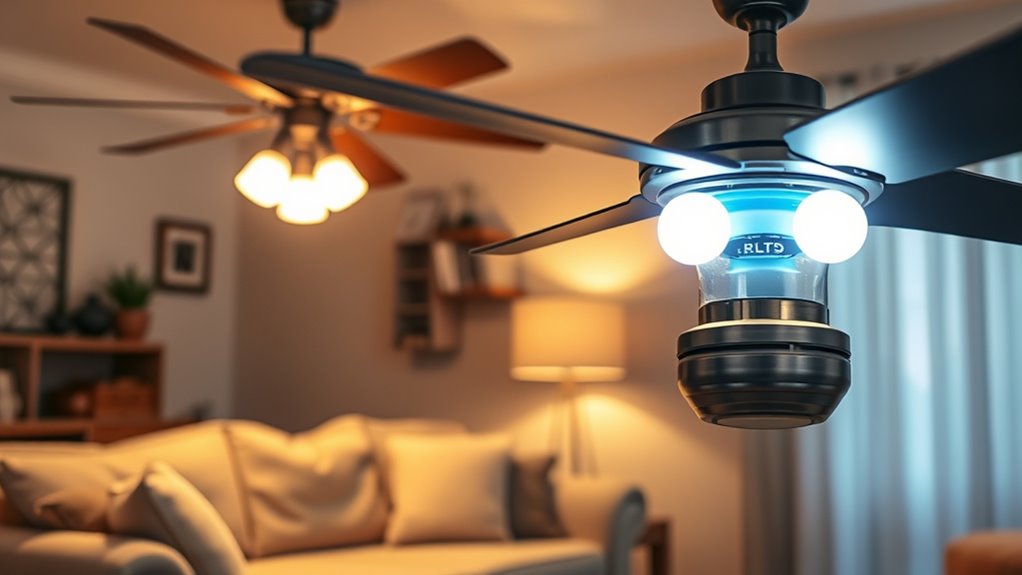
Choosing the right fan light depends on the room’s function and mood you want to create. Consider how light color and brightness influence the space, making it more relaxing or energizing. Matching the light to the room’s purpose guarantees it’s both functional and inviting. Additionally, understanding the store hours of your preferred beauty retailer can help you plan your shopping trips effectively. Selecting the appropriate color temperature can significantly impact the ambiance, so take into account the room’s activities and desired atmosphere. For optimal results, consider the best soil for surrounding plants, which can complement the lighting and enhance the overall environment.
Room Function & Mood
The function and mood of a room should guide your selection of fan lights, ensuring the lighting enhances both the space’s purpose and atmosphere. For a cozy living room, opt for warm, soft lighting that highlights decorative accents and creates an inviting feel. In a kitchen or workspace, brighter, cooler light boosts alertness and energy efficiency. Bedrooms benefit from gentle, warm tones for relaxation, while dining areas need bright but comfortable lighting to set an inviting mood. Consider this visual guide: color temperature, which plays a crucial role in establishing the desired ambiance. Additionally, understanding how lighting features influence perception can help in choosing lighting that supports well-being.
Light Color Compatibility
Ever wondered how the color of your fan light can influence a room’s mood and functionality? Choosing the right light color guarantees your space feels inviting and serves its purpose. For living rooms or areas with decorative accents, opt for warm white or soft yellow to create a cozy atmosphere. In workspaces or kitchens, cooler tones like daylight or bright white boost alertness and enhance visibility. Consider energy efficiency when selecting light colors—LED options with adjustable color temperatures let you switch between moods while saving energy. Matching your fan light color to the room’s purpose helps highlight decorative accents and creates harmony. Ultimately, the right light color not only improves ambiance but also supports your room’s functionality and aesthetic appeal.
How to Adjust and Customize Your Fan Light’s Color Temperature

Adjusting your fan light’s color temperature is usually straightforward and allows you to set the perfect ambiance for any room. To do this, check if your fan light has adjustable settings or a remote control that lets you change from warm to cool tones. Be aware that some LED lights might flicker if not compatible with dimmers, so ensure your dimmer switch is compatible with LED bulbs to avoid flickering issues. If your fan light supports dimming, you can fine-tune the brightness and warmth easily. For more precise control, consider smart fan lights that can be customized via an app, giving you the flexibility to adjust color temperature seamlessly. Proper setup guarantees your space feels inviting and tailored to your mood.
Frequently Asked Questions
Can Changing Color Temperature Impact Sleep Quality?
Changing color temperature can definitely impact your sleep quality. Cooler light temperatures, like blue or white, can disrupt your sleep patterns by suppressing melatonin production, making it harder to fall asleep. Warmer tones, such as yellow or orange, promote relaxation and help establish calming bedtime routines. Adjusting your room’s color temperature before bed can improve your sleep quality by signaling to your body it’s time to wind down.
Are LED Fan Lights Better for Mood Than Incandescent Ones?
Sure, LED fan lights are the mood boosters, right? They beat incandescent ambiance hands down with their LED efficiency, lasting longer and using less energy. But if you’re after that warm, cozy glow that makes you feel like you’re in a nostalgic movie scene, incandescent bulbs still have their charm. So, choose LED for efficiency or incandescent for mood—your call, but don’t expect both in one bulb!
How Does Natural Light Influence the Perceived Color Temperature?
Natural light considerably influences your perception of color temperature in a room. During the day, natural light enhances color perception, making colors appear more vibrant and true to life. It varies throughout the day, shifting from warm tones in the morning and evening to cooler midday light. This dynamic lighting affects how you feel and perceive your space, highlighting the importance of balancing natural and artificial lighting to create the desired mood.
What Are the Energy Savings Associated With Different Color Temperatures?
You might be surprised, but choosing the right color temperature can save energy. Cooler bulbs often use less energy and have longer lifespans, reducing your overall energy consumption and maintenance costs. Warmer tones, while cozy, tend to consume more power and burn out faster. By selecting efficient bulbs with ideal color temperatures, you maximize savings and enjoy longer-lasting lighting, making your space both energy-smart and inviting.
Can Color Temperature Adjustments Help Alleviate Seasonal Affective Disorder?
Adjusting color temperature with fan lights can support mood regulation and help alleviate seasonal affective disorder (SAD). Cooler, bluish light mimics natural daylight, promoting alertness and improving mood, much like light therapy. Warmer tones create a cozy atmosphere but may not be as effective for SAD. Using adjustable lights allows you to tailor the environment, making it easier to combat seasonal lows and boost overall well-being.
Conclusion
So, next time you pick a fan light, remember—choosing the perfect color temperature isn’t just about style, it’s about mood. Ironically, what feels cozy or energizing is entirely up to you, yet often overlooked. Don’t be that person stuck in a dull or overly harsh space. Instead, have fun experimenting. After all, your room’s vibe is just a switch away—who knew something as simple as light could make or break your mood?


